Yu. N. Sharikov1, K. E. Yakobson2, O. N. Komissar3, Ya. V. Kusmin4, E. G. T. Jull5
1Sochi State University, Anapa Branch, Anapa, 353454, Russia
2All-Russian Scientific-Research Geological Institute, St. Petersburg, 199106, Russia
3Obninsk Research and Production Enterprise "Technologiya", Obninsk, 249031, Russia
4Institute of Geology and Mineralogy, SBRAS, Novosibirsk, 630090, Russia
5NSF-Arizona AMS Laboratory, University of Arizona, Tucson, Arizona, 85721-0081, USA
Correspondence to: Yu. N. Sharikov, Sochi State University, Anapa Branch, Anapa, 353454, Russia.
| Email: |  |
Copyright © 2012 Scientific & Academic Publishing. All Rights Reserved.
Abstract
Caucasian dolmens are the most mysterious archaeological phenomenon of the early Bronze Age. The investigation of dolmens structural features revealed a number of contradictions in the traditional view of the dolmen construction technology. The discovery and examination of Caucasian fluidolites made it possible to see the technology of the megalithic structures construction in a new light. A new hypothesis for the origin of megalithic structures in other parts of the world has been put forward.
Keywords:
Dolmens, Megaliths, Bronze, Geology, Fluidolites
Cite this paper: Yu. N. Sharikov, K. E. Yakobson, O. N. Komissar, Ya. V. Kusmin, E. G. T. Jull, Investigations, Reconstruction and Geological Aspects of Dolmen Construction Technology in the North-West Caucasus, Archaeology, Vol. 2 No. 2, 2013, pp. 38-46. doi: 10.5923/j.archaeology.20130202.04.
1. Introduction
There are megalithic cultic structures in the North-West Caucasus from Taman to Abkhazia which the locals (Adygeis) called “ispun” translated as “houses of dwarves”. Today these megaliths are called dolmens. The dolmen culture in the Caucasus covers the period from the middle of IV to the end of II millennium B.C. These ancient mysterious structures gave name to one of the Bronze Age culture lines – dolmen culture (Fig. 1). The Caucasian slab dolmen is a chamber built from several ideally connected stone blocks covered with a slab. The dolmen structure always includes a portal formed by the projecting blocks of the side walls and overhanging roof slab. Sometimes some slabs were added to the portal. There is usually an access hole 38±5 cm in diameter in a lower third of the portal, somewhere in the centre. The stone blocks, from which the dolmens are built, can weigh up to several tons. The dolmens were built from slabs or individual blocks, caved in a lump of rock or in the rock itself. The variety of dolmen structures is striking. In 1960 г. L.I.Lavrov proposed the classification[1] according to which he specified four basic types of dolmens: slab, built-up, semi-monolithic and monolithic (Fig. 2).The slab dolmens were built from six slabs: foundation or heel stone, two side slabs, portal slab, rear slab and cover slab. According to V.I. Markovin[2], 92% of all dolmens are slab ones. The built-up dolmens consist of several large blocks and the chamber formed by these blocks is covered by the roof slab. The semi-monolithic or trough-shaped dolmens were caved in a lump of rock. They are also covered with a roof slab. The monolithic dolmens were caved in the rock through the hole. 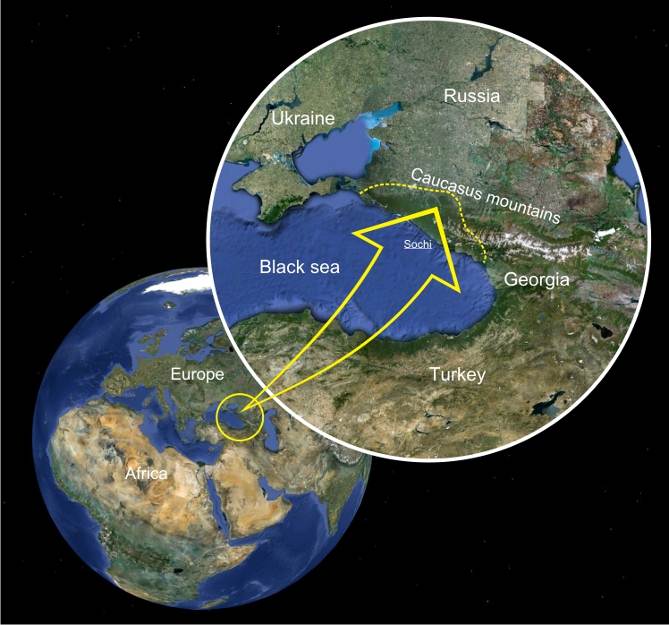 | Figure 1. Map of dolmen locations in the North-West Caucasus (Russia) |
The megalithic structures are met in other parts of the world but the characteristic feature of the West Caucasion dolmens is the superaccurate mating of multiton stone slabs. Even a sheet of paper cannot be inserted between the stone blocks of well-preserved dolmens, although the line of blocks coupling is curved. 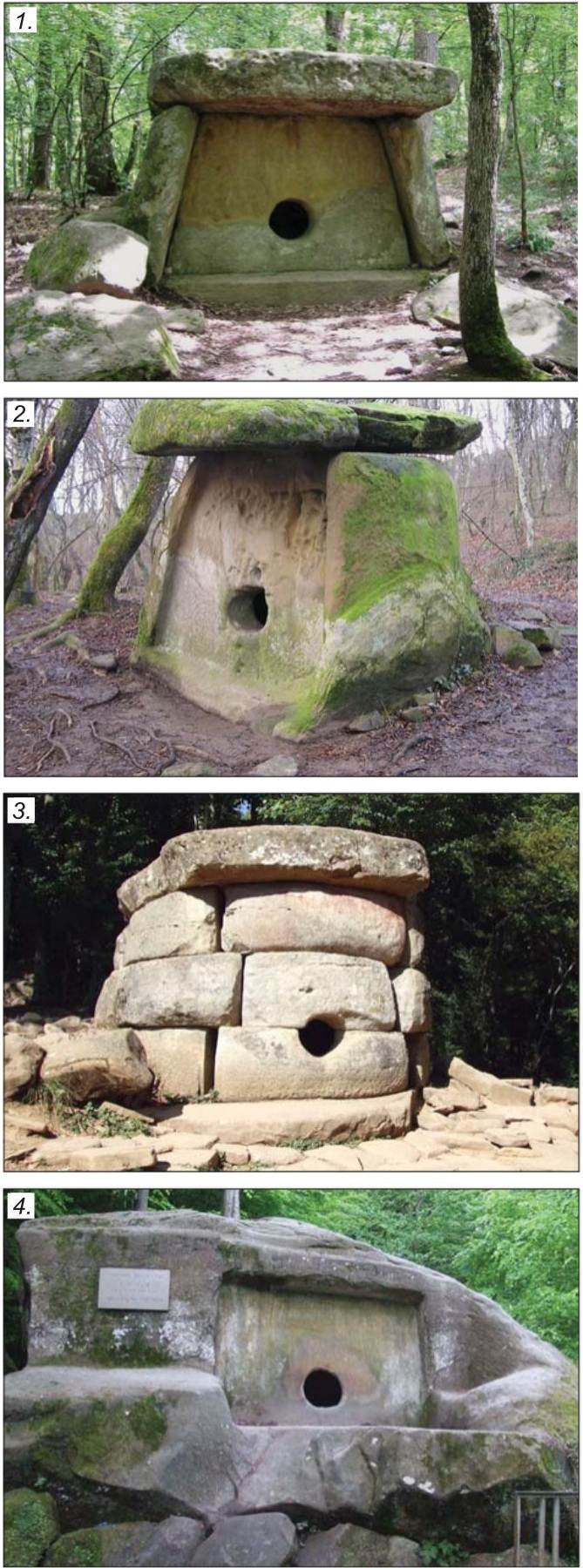 | Figure 2. Dolmen types according to L.I. Lavrov’s classification. 1). Slab dolmen, “Dolmens village” group, Pshada Settlement (Gelendzhik Area, Krasnodar Territory). 2). Semi-monolithic dolmen, Pshada neighborhood. 3). Built-up dolmen, Zhane River, Vozrozhdeniye Settlement (Gelendzhik Area, Krasnodar Territory). 4). Monolithic dolmen, Godlik River, Volkonka Settlement (Lazarevskoye Area) |
In 1971 Markovin excavated Deguaksko-Dakhovskaya settlement where in the author’s opinion lived the builders of dolmens[2]. These people had poor technical equipment. They did not know iron, potter’s wheel, they ploughed up the soil with a mattock and did not know about the plow which was already in use in the East. The excavations showed that the builders of dolmens lived in adobe miserable hovels. No instruments and technical devices for building dolmens were found during the excavations. Yet they built the structures which boggle the imagination of the people today.
2. Dolmen Construction Problems
There are a lot of hypotheses which explain the nature of dolmens. All of them boil down to the statement that dolmens are megalithic structures built from stone slabs and blocks or caved in rock mass. But this interpretation does not explain the following problems of dolmen construction in the days of early Bronze Age: →How and where did the builders get huge sand blocks of required size?→How did the builders transport the multiton blocks to the place of dolmen construction in the absence of roads in the mountainous areas?→How and with what instruments did the builders mill the stone?→How did the builders obtain smooth mating of multiton blocks with curvilinear joint lines?→How did the builders write raised marks on the blocks surface?→What is the origin of this sublime culture and why did it disappear in one and a half thousand years living us thousands of dolmens over the vast territory of the North-West Caucasus?Let’s discuss each of these problems in greater detail.
2.1. Stone Quarries
Many authors make mention of the ancient stone quarries in which the building blocks of future dolmens were hewn out. In Markovin’s opinion the stone was cleft in the following way[2]: “then the wooden wedges were forced into the prepared cavities and watered, they swelled and as a result the cracks appeared in the stone.” Technological information. To cleave the stone in a required direction, the holes for wooden wedges must be drilled along the line of stone splitting through no less than 75% of its width with the 20-30 cm intervals between each other. The traces of holes on the stone cleavage reasonably should be seen but none of dolmen blocks have such traces. We examined some areas known as “ancient stone quarries”. In fact they are sandstone yields, often of bizarre form. There were no traces of stone working in any of these places. Although the lumps of sandstone were found in close vicinity to all dolmens or dolmen clusters.
2.2. Transportation
The builders of dolmens were faced with a very complicated and far from trivial transportation problem. How could the multiton stone blocks be transported to the dolmen construction site in the total absence of roads in the mountainous areas? Markovin believes that it was as follows[2]: “So the slabs in the raw state are hewn out. They must be transported to a building site. It was carried out with the help of rollers (logs of the same shape), ropes, human and bull power. A very old method.” This method is not as simple as it might appear at first sight. In the first place, the road is indispensable, the road as an engineering structure providing a plane surface in the mountainous area for the transportation of multiton blocks without the risk of side sliding and very steep lifting angle. The road surface must be strong enough in order that the multiton blocks should not force the rollers into fragile soil. There are not any roads in the vicinity of most dolmens and they are located in hard-to-reach (even today) areas.
2.3. Stone Working
All dolmen researchers emphasize the following peculiarity: the stone blocks from which the dolmens consist are rough on the outside and look like natural stones. But the portal slab and the inner surface of the chamber are smooth and plain. Of special interest is the close fitting of slabs. The marks of stone working in the form of hacks can often be seen on the inner surface of the chamber and portal This is how Markovin describes the process[2]: “Wedge-shaped stone and bronze instruments were used. They are well polished and resemble the plane iron. The marks of their usage are visible on the walls of many trough-shaped dolmens. Their blades were 3-4 cm in width. The grindstones (rounded stones with a wider working section or base) finished the work: they brought the slabs to a required degree of finish and smoothness.”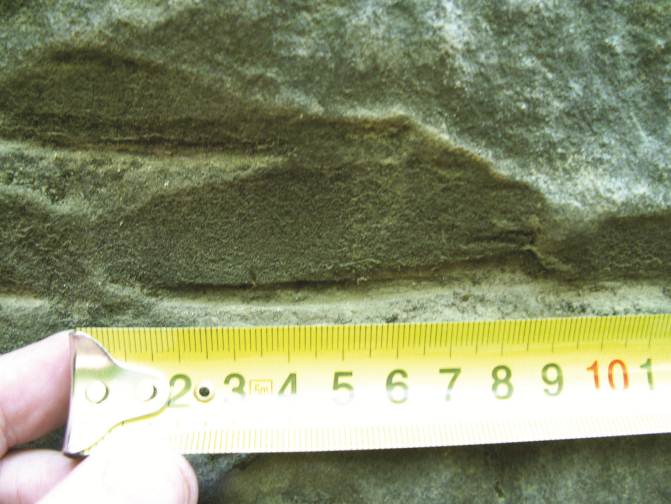 | Figure 3. Traces of instruments on the portal slab |
On the inner surface of the chamber and the outer surface of the portal of some dolmens the traces of stone scabbing in the form of hacks left by the instrument blade 3-9 cm in width are clearly seen (Fig. 3). The length of the stone scabbing section is 1- 4 cm. When drawing a comparison between the sandstone surface sheared with a pitching tool and the dolmen surface with the traces of tools, it becomes evident that the dolmen stones were not cleft[4].A pitching tool leaves shatters. The hacks on the dolmen blocks more closely resemble the traces of the putty spattle on the unset mortar. The bronze instruments which in Markovin’s opinion resemble the plane iron also look more like putty spattle than like the boaster. Thin bronze instruments cannot cleave the stones.
2.4. Blocks Mating
The surfaces of blocks are ideally mated although the line of coupling is often curved. The extent of their mating in well-preserved dolmens is striking (Fig. 4). It is difficult to imagine that the multiton blocks were all the time lifted and droved as in this case the blocks would be shifted relative to each other and the coupling line wouldn’t be so conformal[4].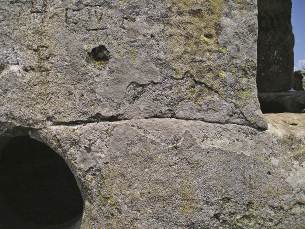 | Figure 4. Fragment of dolmen portal slab with absolutely conformal lines of blocks coupling. Mount Neksis (Gelendzhik Area) |
A.A. Formozov describes in his paper “Primitive Art Monuments” the attempt to transfer a well-preserved dolmen which demonstrates that smooth mating of blocks is a very difficult problem and perhaps unrealizable without special powerful equipment[3]. “It was decided in 1960 to transfer one of the dolmens from Esheri to Sukhumi, to the territory of Abkhazian museum. The smallest dolmen was chosen and a hoisting crane approached it. The steel-wire rope was attached to the cover slab in a variety of ways but all efforts to move the slab were ineffective. The second hoisting crane was called. Two cranes removed the multiton block but could not lift it and load into the lorry. The whole year the roof had been in Esheri when a more powerful mechanism was shipped to Sukhumi. In 1961 all the stones were loaded into the lorries with the help of this mechanism. But the most difficult task was ahead: to rebuild the house. The house was only partially rebuilt. The roof was put on four walls but the builders did not manage to turn it in such a way that the edges of walls should get into the grooves on the inner surface of the roof. In ancient times the slabs were so tight fitted that even the blade of the knife couldn’t be inserted between them. But here there was an ample clearance.”How did the builders in the yearly Bronze Age obtain high-accuracy fitting of multiton blocks without special building equipment (although the episode in Esheri shows us that special building equipment does not always solve the problem)? There is no answer to this question today.
2.5. Petroglyphs
There are raised patterns (petroglyphs) on the face slabs of some dolmens (Fig. 5). To obtain such a relief, the builders would have to grind off the layer from the whole surface of the face slab. However the bas-relief is made very accurately. The stone surface is smooth and has no traces of stone working. The work on the creation of this bas-relief is very labor-intensive and involves the use of very sophisticated stone working technology and special equipment[4].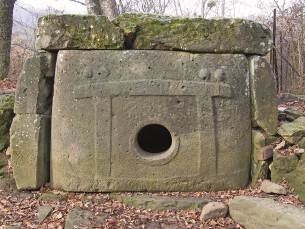 | Figure 5. Petroglyphs on the dolmen portal slab in Shirokaya Shchel’ Settlement |
2.6. Technological Elements and Polygonal Masonry
There are interesting artifacts on the structural components of dolmens the occurrence of which cannot be explained by machining and blocks fitting[4].The cover slab of dolmens looks like a natural stone with the congealed solution texture and has sloping rounded faces and corners. On the lower face of the cover slab one can often see a clear boundary formed on the principle of spreading of plastic mixture over a hard horizontal surface. The end surface of the slab is of rounded shape and has no traces of stone splitting or working (Fig. 6).In case of large cover slabs a clear boundary between the side face and upper and lower slab surfaces can be seen on the side and front faces. The upper surface of the slab is rounded and merges sharply with the side face, as if the plastic mixture spread over the surface bounded by the formwork, most probably by the earth formwork (Fig. 7).On the bottom side of the cover slab most dolmens have burrs and grooves strictly corresponding to the upper edges of slab end faces. There are no traces of stone working.The side slabs of the slab dolmens are of lenticular shape in the area of cutting, with the convexity being extrorse. The inner surface of the slab is absolutely smooth. The end faces of the slabs look like natural stone and there are no traces of holes on them. 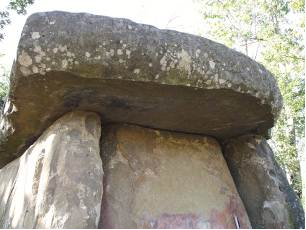 | Figure 6. Dolmen in Pshada Settlement. End and bottom surfaces of the cover slab. The slab was poured on the smooth surface and the plastic mixture formed a clear boundary of spreading |
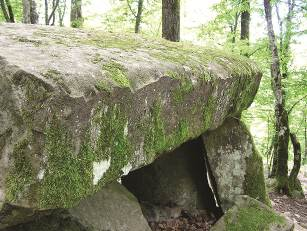 | Figure 7. End face of dolmen cover slab in Pshada Settlement |
Under close examination of dolmen slabs one can see a variety of artifacts: boundaries of mass contact, flow texture, gas bubbles, embedded pieces of rock. The ideal coupling of complex-shaped blocks along the curved coupling line is particularly well seen in built-up dolmens. The built-up dolmen on Mount Neksis in Gelendzhik Area is an example (Fig. 8). The quality of coupling of wall and cover slab multiton blocks boggles the imagination. The side blocks have the inverted-L shape, they bend and form a rear wall. The coupling lines are curved but the matching of blocks is absolutely conforming[4].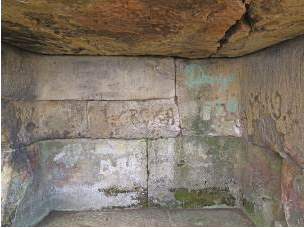 | Figure 8. Polygonal masonry of the rear and side walls of the dolmen on the Mount Neksis. Ideal mating of cover and base slabs is well seen |
The above mentioned examples of plastic making of blocks led us to the conclusion that dolmen elements were formed from plastic mixture but not by stone cleaving and boasting.
3. Fluidolites
The term ‘fluidolite’ (formed from the word ‘fluid’- a substance that has no fixed shape and yields easily to external pressure - and from Greek lithos -‘stone’, i.e. a stone formed by a fluid ) was officially introduced into the slang of Russian geoscientists in 2009 in the meaning of geological materials and bodies formed from them, with the decompression fluid flows of different genesis playing the dominating role in their formation. These flows lead to different phenomena: penetration or impregnation of a fluid matter into the enclosing medium, mostly layer-by-layer; fault or extraction of individual ingredients, particularly ore ingredients; fixation of the fluid matter in another medium, and, finally, formation of rocks and geological bodies with specific characteristics. Moreover, these rocks are characterized by the ability of fluid flows to transfer the suspended mineral grains of deep-seated origin and the fragments of hypogene melts, glassy and crystalline solids, which, along with the above phenomena, mostly leads to the formation of mineral species. The processes, as a result of which a plastic mixture consisting of a fluid and fragmentary material (sand, debris, breccia) and characterized by subsequent lithification may flow from the deeps onto the earth surface and near-surface layers, have been considered in geological literature from different viewpoints (Fig.9). According to the generalized geological model of the formation of upward fluid flows of different genesis, the corresponding rocks take quite a natural place[5,6].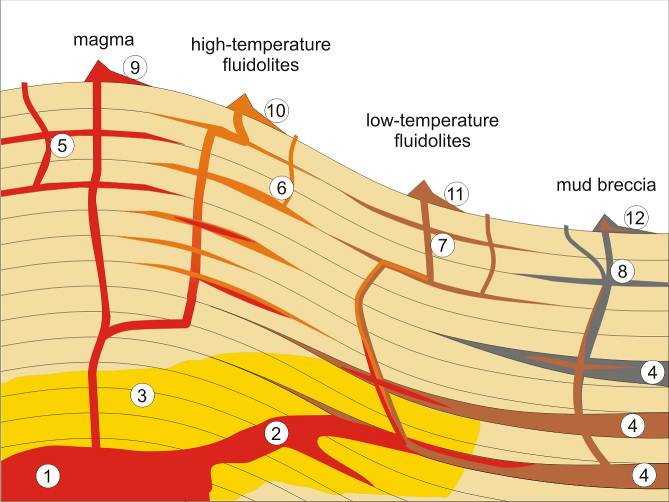 | Figure 9. Geological model of upward fluid flows formation: 1 –bathylite, 2 – typhon, 3 – thermometamorphism zone, 4 –low-temperature fluids zones (geopressured zones), 5 – intrusive magmatic rocks, 6 – intrusive high-temperature fluidolites, 7 – intrusive low-temperature fluidolites, 8 – intrusive mud breccia, 9 – effusive magmatic rocks, 10 – effusive high-temperature fluidolites, 11 – effusive low-temperature fluidolites, 12 – mud breccia outflows |
V. N. Kholodov writes in his work “On the Nature of Mud Volcanoes”[7], “When the sand formation enters the zone of decompactification and extra-high pore pressure, it turns into a quicksand; the ductility values of sandstone and clay equalize, and they both flow as highly plastic and similar materials. In some cases, the pore pressure difference in clays and sandstones is so big, that a more intense hydraulic fracturing takes place as a result of their contact; under a heavy pressure the fractures are injected with the fluidized sand, which fills them, and then the pulp-dissolved components harden the fluidized sand after the decompression. This is how the formation of sand dikes, impure horizons, diaper apophyses and other consequent bodies takes place, which is described in a number of our earlier works. In many cases, it is the mud volcanoes that they are associated with, which suggests that the area of similar formations may include both the fluidized clays and fluidized quicksands. It is particularly typical for the mud volcanoes of Turkmenia, where the mud breccias many a time contain sandstone bodies of the most fantastic shape” (Fig. 10).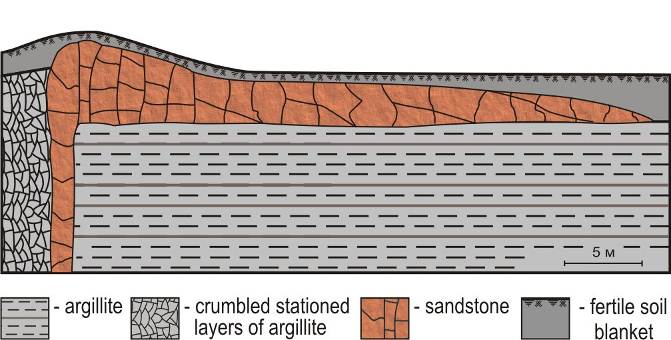 | Figure 10. Schematic representation of the structure of the right Zhane River bank, 80 meters below the first waterfall. In this place, perpendicularly to the river flow, the river bed is crossed by the sandstone formation, which is detected in the right bluff, and forms a mushroom-shaped effusive body on the flat-lying argillite formation |
The members of A.P. Karpinsky Russian Geological Research Institute consider the process from other viewpoints. “The Petrographic Code of Russia”[8], published in 2009, describes these rocks under the name of ‘fluidolites’ and defines them as a novel type of endogenic rocks. Fluidolites were formed as a result of fluid matter penetration (impregnation), mostly layer-by-layer, into the enclosing medium; fault or extraction of individual ingredients, particularly ore ingredients; fixation of the fluid matter in another medium, and, finally, formation of rocks and geological bodies with a characteristic structure. Fluidolites have been found in different geological conditions not only in folded regions, but also on paleoplatforms[9]. The book “Fluid Explosive Formations in Sedimentary Complexes” is about the structure of these materials[10]. It should be noted that describing the hypogene diamond fluidolites in the doctoral thesis, I.I. Chaikovskiy classifies them as the products of explosive and mud volcanism. At the sites of the supposed extraction of raw materials for the dolmen construction, the bedrock outcrops and blocks of massive sandstone are characterized by specific plastic strains developed during their formation. One can observe the contact marks of masses forming geological bodies and the enclosing rocks marks (Fig. 11). There exists a specific ‘bread crust’ type cracking of sandstone surface. The blocks of sandstone have different textural features due to the rock formation discontinuity and multiple impulsiveness. Fragments of argillite, malm, and chalkstone entrapped from enclosing rocks are commonly recognized in sandstone. The outcrops of the block sandstone in Pshada’s rock mass close to the well-known semi-monolithic dolmen were investigated during the field works (Fig. 2-2.). The sandstone has been characterized by the diversity of fragmentary material mixtures.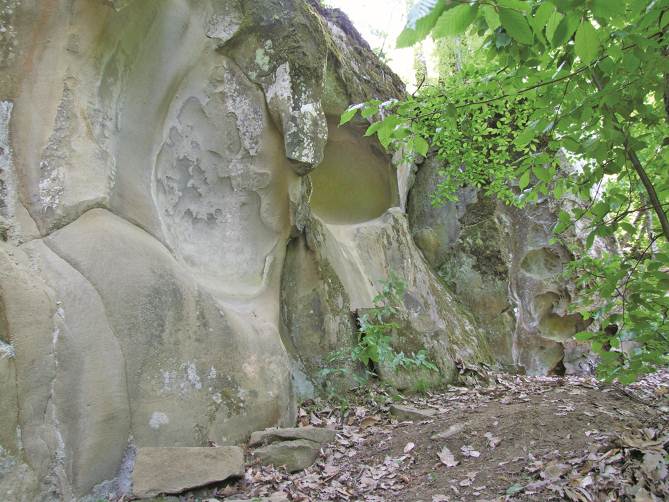 | Figure 11. Sandstone structures brought into focus by weathering in the neighbourhood of Pshada |
In places, the fragments of argillite and plant detritus trapped during the period of rock mass formation have been found in sandstone. It has been found out that the rock has bitumen and xylantrax inclusions in different zones of the rock mass horizon. The tree limb fragment with a diameter of 20 mm and an overall length of 185 mm attracts the most interest (Fig. 12). 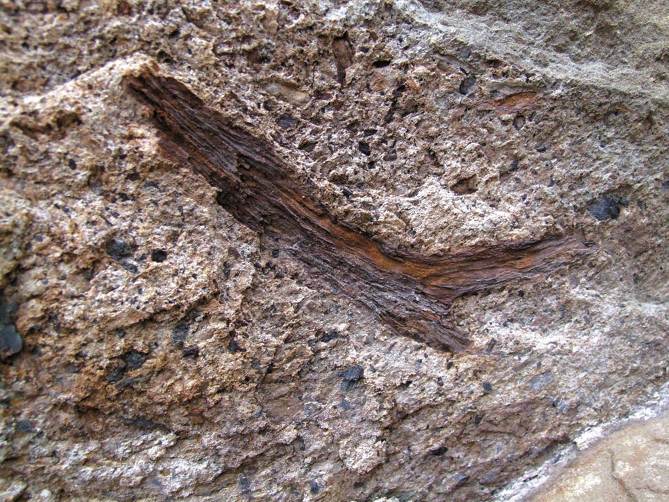 | Figure 12. The tree limb fragment in sandstone |
The find is unique, because the organic matrix of the tree has preserved in the limb. The absence of the completed processes of inorganic compounds substitution followed by fossilization has allowed a tentative conclusion to be made on the possibility of using carbon-14 dating and an extremely young geologic age of diapirism processes (arching phenomenon of plastic sedimentary rocks), which resulted in the rock mass formation under investigation in the neighbourhood of Pshada. The upper limit of the radiocarbon dating, which nowadays makes it possible to determine the age of specimens of up to 40-50 thousand years and, under favourable conditions, up to 60 thousand years, is near the time boundary between the middle and late Paleolithic Age[5]. The radiocarbon dating has been used to determine the age of carbon contained in the tree limb, which was found in the rock of the dolmen built near Pshada. This is the first attempt known to us to evaluate the time of fluidolites formation in the Caucasus. The measurements were carried out in 2010, using an accelerating mass-spectrometer (AMS) produced by the company NEC (the working voltage stress is 3 MeV), in the Accelerator Mass Spectrometry Laboratory of the National Science Foundation of the USA, the University of Arizona (Tucson, USA). The test specimens were prepared in compliance with the method described in the work[11]. According to the results got, the specimen of the charred wood in the rock dated back to 42,100 ± 1,500 years ago and the specimen of the tree limb in the rock dated back to 24240 ± 190 years ago. It means that the sandstone of Pshada’s rock mass, which was used for the construction of a number of dolmens in the neighbourhood, formed in the era corresponding to the upper Paleolithic age. The data are critical for further research, since they demonstrate that the rock used for the dolmens is of quite a ‘young’ geologic age –it can in no way belong to Mesozoic!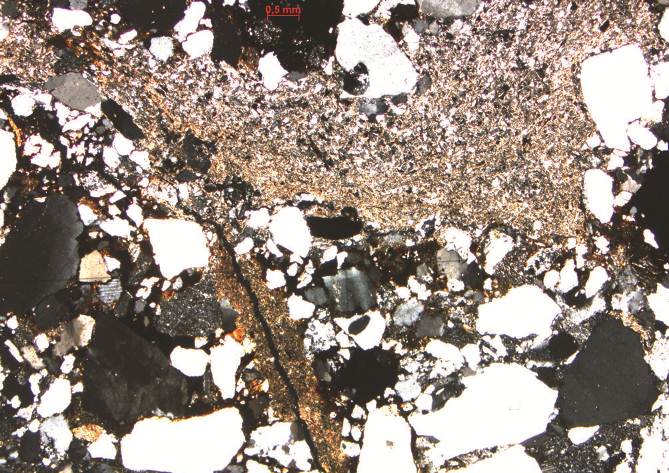 | Figure 13. A polished specimen taken from the rock nearby Pshada. The trace of the fluidal microflow consisting of silty argillite. The consertal sandstone (mixtite) with fine-grained (0.07-01 mm) and coarse-grained (1.00 mm) debris. The length of the graduated scale is 0.5 mm |
The conclusion on the fluidic nature of the dolmen material is also confirmed by petrographic investigations. The polished specimens have the following features, which are characteristic for fluidolites and similar to those described in the Atlas of Structures and Textures of Fluid Explosive Rocks[12]: the mottled structure as a result of different debris-cement combinations; the fragments of enclosing rocks in the rock; the traces of organic matter; the signs of the outward mineral grain-and-lithoclast disintegration with centrifugal arrangement of their parts having conformal boundaries and the filling of new incipient cracks with groundmass; the nonequilibrium intermixture of mineral grains; and a specific petrochemical composition of the rock (Fig. 13, 14).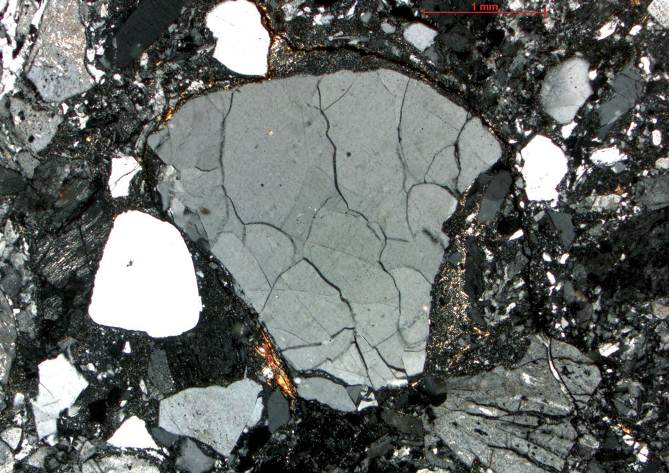 | Figure 14. A polished specimen taken from the rock nearby Maloye Pseushkho (Tuapse Area). The psammitic, lithic-crystal, clastic acid tuff containing 85–90% of fragments (mostly cracked) of quartz crystals and fieldspars. The fragments are angular and in many cases have the signs of ‘in-situ fragmentation. The length of the graduated scale is 1.00 mm |
The petrographic analysis of the dolmen rock and fluidogenic sandstone samples, which were taken from the neighbouring rock outcrops, shows that both the fragmentary material and the cement are similar in their mineral composition. The composition of the dolmen sandstone and that of the rock outcrops sandstone proved to be completely identical (Fig. 15, 16). This permits the source of the constructional material to be defined accurately.Due to a specific running exterior surface of the rocks and their high quartz content, these materials are often referred to as ‘tuberous quartzites’ in the world literature[13, 1]. 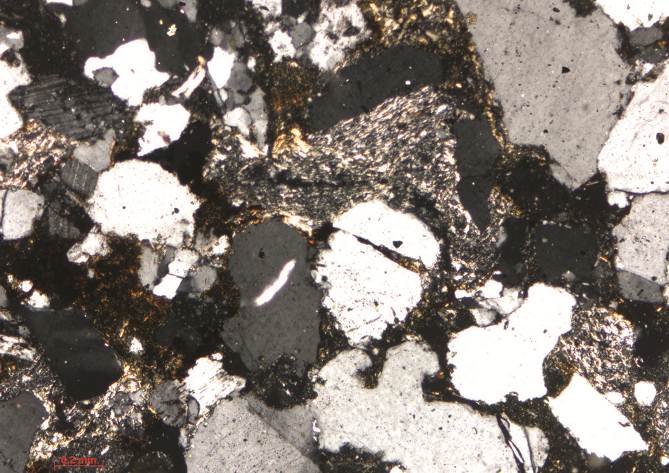 | Figure 15. A polished specimen taken from the dolmen rock in Pshada. The medium-grained sandstone with the traces of fluid processes. The signs of fragmentation and resorption of grains are clearly defined. The two grains in the upper right corner of the photograph are related to each other in a straight line – the mark of a penecontemporaneous stress. The length of the graduated scale is 0.2 mm |
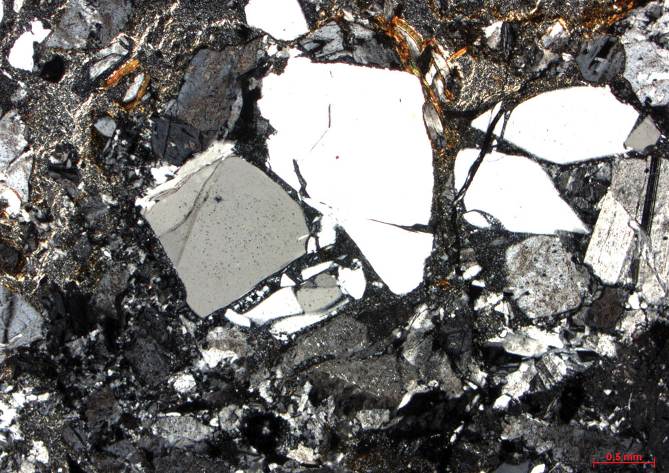 | Figure 16. A polished specimen taken from the dolmen rock in Maloye Pseushkho. The rock type is similar to that of the dolmen in Pshada. The signs of penecontemporeneous grain fragmentation are even more clearly defined; the intergrowths of potassium fieldspar and biotite are seen as well. The length of the graduated scale is 0.5 mm |
The results of the integrated research carried out showed that the dolmens were built from the rocks close to the location of megaliths. The distance between the dolmen and rock outcrops is normally from several tens to several hundreds of meters.
4. Technology Reconstruction
The data given by us make it possible to guess which technology had been used for the dolmen construction. The dolmens and their separate elements were cast or moulded out of fluidogenic mass (low-temperature <100º and plastic) in situ. This is how the dolmen of the most common slab-type could have been built (Fig. 17).The basin of the dolmen to be built was filled with fluidogenic mass to form the structure base – an abutment stone. The slab moulds -future side walls- were cut in the ground and filled up (Fig. 17-1).The mortar having had the required structural strength, the slab was upedged with the help of arms. The side walls rested on the supports with a slight lean to each other (Fig. 17-2).A formwork for front and back walls was prepared between side walls using a dirt fill. It is obvious that the mating with the side slabs having grooves was absolute (Fig. 17-3).After preparing the front and back slabs (walls), the whole dolmen appeared to lie under the earth mound (formwork). The dirt fill on the top of the earth mound (formwork) was levelled, and the fluidogenic mass was placed upon it forming the cover plate (Fig. 17-4). Upon mass lithification, the portal had to be unearthed. The earth was taken out from the dolmen through the hole (Fig. 17-5).The built-up dolmens had the abutment stone as well. The formwork was prepared from the dirt fill, and then it was filled with fluidogenic mass. The size of the moulded blocks seemed to depend on the amount of the mortar produced or its quality (setting time), and the time required to get the blocks from the source to the construction site. The joints were ideal, with the blocks having very bizarre forms.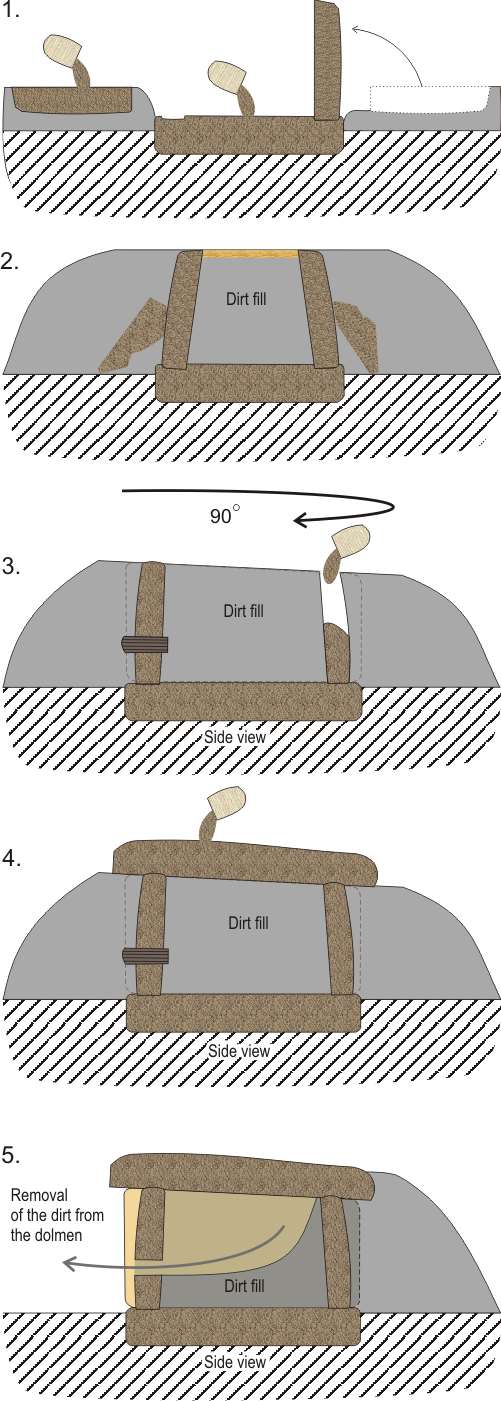 | Figure 17. Reconstruction of successive steps (from top downward) in the slab-type dolmen construction by filling the sand moulds with fluidogenic mass |
The casting technology of dolmen elements from plastic mixture offers an explanation of the ability of a team consisting of several people and having a minimum of simple tools (stone scrapers, baskets, arms) to build a multiton dolmen. The casting technology of dolmen components gives a complete explanation of a fantastic variety of construction solutions and the quality of structural units matching. The further study of the fluidolite formation mechanism will make it possible to reconstruct the technology of these megalithic structures in more detail.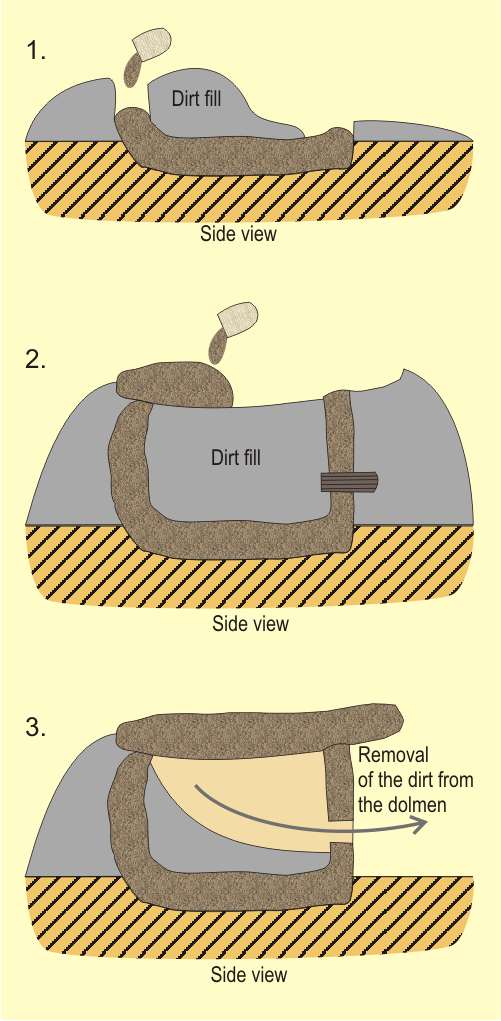 | Figure 18. Stages of construction of a semi-monolithic dolmen |
Builders were able to produce pouring of a dolmen continuosly if quantity of fluidogenic mass was enough. Semi monolithic dolmens were built such way: shallow trench was digged at the place of the future dolmen. The place of this trench corresponded with the bottom of the future dolmen. At this place builders poured fluidogenic mass (Fig. 18-1). Than they shaped inside space of the dolmen and it's outside formwork with dirt. Pouring and shaping of formwork were made continuously. As a result of this continuous technology: builders got the monolithic "trough". At the site of the dolmen portal builders shaped formwork for the manhole. The ends of the filled walls and the dirt filling the dolmen inside space formed a plane for pouring the cover slab (Fig. 18-2). Fluidolite cemented. After this builders dug out the dolmen portal, took out the formwork for manhole and dirt from the dolmen (Fig. 18-3).
5. Conclusions
The dolmen formation model proposed by us allows an explanation of the aforesaid problems related to their construction:There was no need for the dolmen builders to draw big sandstone blocks from quarries;Fluidogenic masses were hand-carried from the location of their outcrop to the dolmen construction site. It was not necessary to lay out special roads with such transportation;To form the structural elements of the future dolmen, the fluidogenic mass was placed against the earth form or, when it was possible concerning the ‘mortar’ viscosity, the future element was formed (moulded) in situ;The hewing marks seen on the interior dolmen surface and on the portal may well have been left by stone, bronze and even wooden scraper-spatulas;The super-precision fitting of multiton blocks with curved end joints, which astonishes greatly all people, is typical for moulding or casting technology;The three-dimensional signs and petroglyphs on the slab surfaces could have been the result of moulding or unlithified fluidolite carving;The dolmen culture came into being during the course of active geologic processes with fluidogenic mass outflows on the territory. In time, the geologic activity faded, the outflows stopped, and the dolmen culture ceased to exist without constructional material.The geologic conditions for the fluidolites in plastic state to outcrop are not unique and peculiar to the Caucasus. There are a great many regions where the geologic conditions for the nucleation of fluids and their outcrops are being created. It is possible that during a certain historical period and on the assumption that the regions of fluidolite outcrops were inhabited by the ethnos with some firm religious beliefs, there existed the conditions under which people used the fluidogenic mass to build hieratic megalithic structures.
References
| [1] | Марковин В.И. Дольменные памятники Прикубанья и Причерноморья. М., 1997. (Markovin V.I. Dolmennye monuments of Prikubanya and Black Sea Coast. M., 1997.) |
| [2] | Марковин В.И. Дольмены Западного Кавказа. М., 1978. (Markovin V.I. Dolmens of Western Caucasus. M., 1978.) |
| [3] | Формозов А.А. Памятники первобытного искусства на территории СССР. Изд. 2-е. М., 1980. (Formozov A.A. Monuments of primitive art in the territory of the USSR. Prod. the 2nd. M., 1980.) |
| [4] | Шариков Ю.Н., Комиссар О.Н. Дольмены Кавказа: геологические аспекты и технологии строительства. Краснодар, 2011. (Sharikov Yu.N., Komissar O.N. Dolmens of the Caucasus: geological aspects and technologies of construction. Krasnodar, 2011.) |
| [5] | Wagner G.A. Age Determination of Young Rocks and Artifacts // Physical and Chemical Cloks in Quaternary Geology and Archeology. Elsevier GmbH, 1998. |
| [6] | Холодов В.Н. Песчаный диапиризм – новая сторона катагенетических процессов // Литология и полезные ископаемые. 1978. №4. С.50–66; №5. С.52–63. (Kholodov V.N. Sandy diapirizm – the new party of katagenetichesky processes // The Lithology and minerals. 1978. No. 4. Page 50-66; No. 5. Page 52-63.) |
| [7] | Холодов В.Н. О природе грязевых вулканов // Природа. 2001. № 11. С.47–58. (Kholodov V.N. About the nature of mud volcanoes // The Nature. 2011. No. 11. Page 47-58.). |
| [8] | Петрографический Кодекс России. Магматические, метаморфические, метасоматические, импактные образования. Изд. 3-е. СПб., 2009. (Petrographic Code of Russia. Magmatic, metamorphic, metasomatic, impaktny educations. Prod. the 3rd. SPb. 2009.) |
| [9] | Якобсон К.Э., Казак А.П., Толмачева Е.В. Туффизиты под Санкт-Петербургом // Природа. 2003. №5. С.61–63. (Yakobson K.E., Kazak A.P., Tolmacheva Ye.V. Tuffizita near St. Petersburg // The Nature. 2003 . No. 5. Page 61-63.) |
| [10] | Казак А.П., Копылова Н.Н., Толмачева Е.В., Якобсон К.Э. Флюидно-эксплозивные образования в осадочных комплексах / Ред. К.Э.Якобсона. СПб., 2008. (Kazak A.P., Kopylova N.N., Tolmacheva Ye.V., Yakobson K.E. Fluid and explosive educations in sedimentary complexes / Editions of K.E.Yakobson. SPb. 2008 .) |
| [11] | Ovodov ND, Crockford SJ, Kuzmin YV, Higham TFG, Hodgins GWL, et al. (2011) A 33,000-Year-Old Incipient Dog from the Altai Mountains of Siberia: Evidence of the Earliest Domestication Disrupted by the Last Glacial Maximum. July 2011. PLoS ONE 6(7): e22821. doi:10.1371/journal.pone.0022821 |
| [12] | Якобсон К.Э., Казак А.П., Копылова Н.Н., Проскурнин В.Ф., Толмачёва Е.В. Атлас структур и текстур флюидно-эксплозивных пород / Ред. К.Э.Якобсона. СПб., 2011. (Yakobson K.E., Kazak A.P., Kopylova N.N., Proskurnin V.F., Tolmacheva Ye.V. Atlas of structures and textures of fluid and explosive breeds / Editions of K.E.Yakobson. SPb. 2011.) |
| [13] | Monika Bernatsky. Megalithgraber: Die Lubbensteine bei Helmstedt // Wanderungen in die Erdgeschichte (19). Braunschweiger Land / Fritz J. Kruger. Munchen, 2006. S. 106 – 109. |
| [14] | Henning Zellmer, Monika Bernatsky. Die Bockshornklippe und "Baustelle Grossteingrab" in Gross Steinum // Wanderungen in die Erdgeschichte (19). Braunschweiger Land / Fritz J. Kruger. Munchen, 2006. S. 110 – 113. |












 Abstract
Abstract Reference
Reference Full-Text PDF
Full-Text PDF Full-text HTML
Full-text HTML





